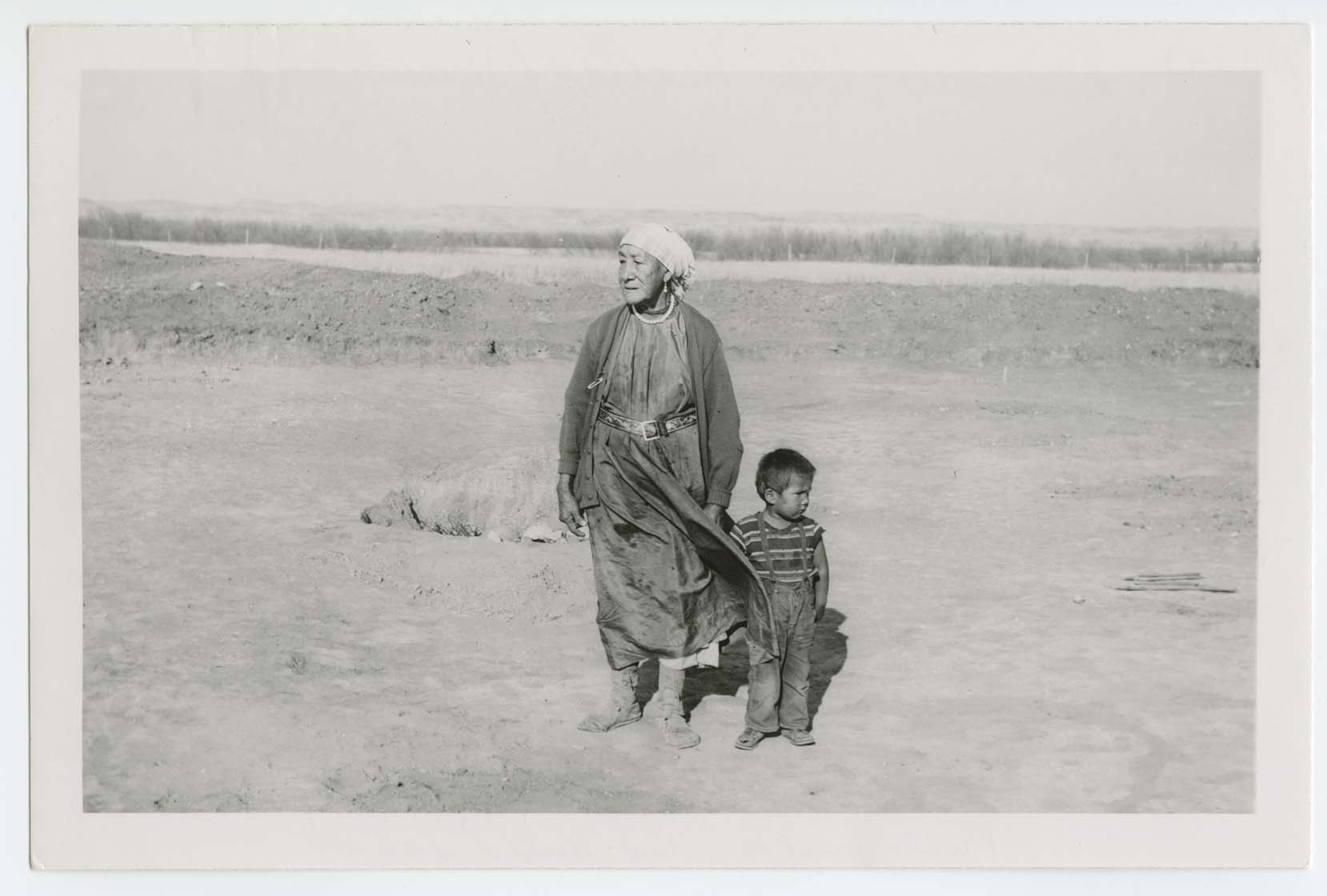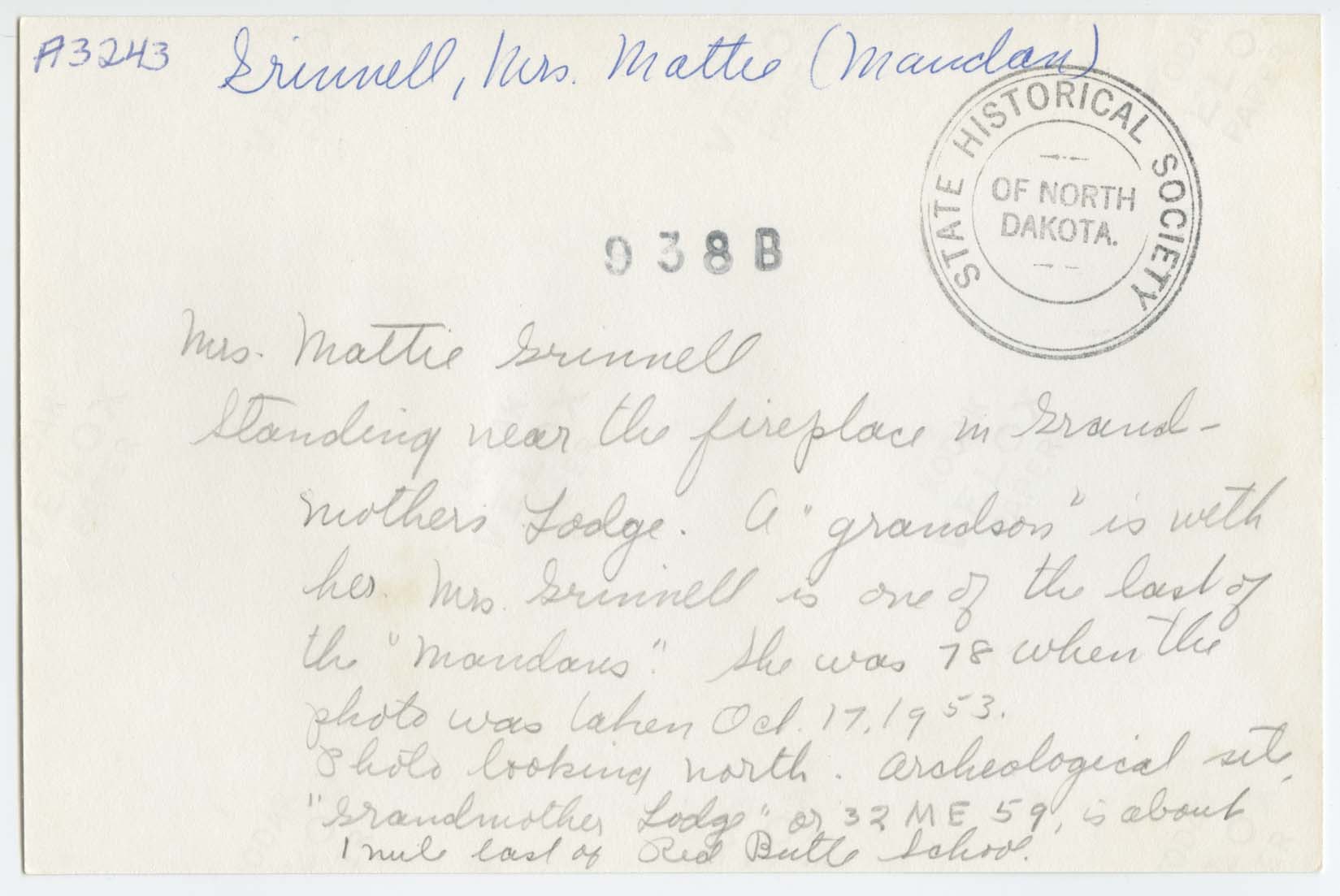Collection: A - A Collection
Folder: 0000.000
Item: 3243_00001
Title: Mrs. Mattie Grinnell and grandson (Mandan) standing near the fireplace in Grandmothers Lodge
Date: 10/17/1953
Inscription/Marks: [back of photo print] A3243 Grinnell, Mrs. Mattie (Mandan). Mrs. Mattie Grinnell standing near the fireplace in Grandmother's Lodge. A "grandson" is with her. Mrs. Grinnell is one of the last of the "Mandans." She was 78 when the photo was taken Oct. 17, 1953. Photo looking north. Archeological site, "Grandmother Lodge" or 32ME59, is about 1 mile east of Red Butte School. [Mattie Grinnell Obituary Bismarck_Tribune_Tue__Jan_7__1975_p15] Mattie Grinnell, Mandan Indian Woman, at 108. Mattie Grinnell, believed to be the last of the full-blood Mandan Indians, died at Twin Buttes Monday evening [January 6th, 1975] at the age of 108. The aged Indian woman had another claim to fame. In 1971, at the age of 104, she was granted a Civil War widow’s pension by a special act of Congress. Three years earlier, at the age of 101, she had taken part in the Poor People’s March on Washington. A proud woman, whose noble visage was lined with the passing of her many years, Mattie remained physically active and mentally alert well beyond her 100th year, and those who traveled to her clay covered log house south of Fort Berthold Reservation gained from her a priceless record of a way of life long vanished from the Dakota plains. Mattie was never sure of her birth date, but remembered that she was born in Like-A-Fishhook Village “when the chokecherries were ripe.” The village was on the Missouri about 20 miles south of White Earth. Her birth was later determined, from school records to have been in August 1866 and the family, she said, selected Aug. 25 as her birthday. Her father, Bad Bull was a scout for the Army, and her mother was Lead Woman. She was given the name Many roads, she said, from the numerous buffalo trails near her birthplace. She attended school at Fort Berthold four years and a teacher there named her Mattie. Her father died when she was 12 years old. She recalled that the government gave them oxen to plow their gardens. “It was much different then, so much better,” she said in an interview last year. Mattie had seen the Indian people moved from the rich bottomlands of the Missouri to the hard, high country with the advent of Garrison Dam, whose waters now cover much of the reservation land along the Missouri. She recalled making buffalo hunting trips with tribal parties to the Badlands and the Black Hills. Feeding the hunting parties was no problem, for there was buffalo and deer meat, corn and chokecherries and plums. The women made corn balls for the hunters. “We ground the corn, mixed it with berry juice and tallow and formed it into balls. Each man took two, giving him the strength he needed for the day’s hunt,” she recalled. She was the only person left in Twin Buttes who could prepare and sun dry beef as in the “old days” and at the age of 102, she was still preparing corn balls and dried beef for tribal ceremonies. As a young girl she knew all the chiefs of the tribes and learned the religious ceremonies and dances. She recalled Indian legends with remarkable clarity. “I still use Indian medicine. That’s why I am over 100 years old,” she once said. When she was 18, she married a German, John Nagel, who was a Civil War veteran, and they lived in a two-room log cabin on the reservation until he died in 1904. In 1907 she married Charles Grinnell. That marriage ended in 1935 and she was left with four children from her first marriage and three from the second. In 1969 her only income was $45 monthly Social Security payment. Friends urged her to apply for a pension as the widow of a Civil War veteran. Because of her second marriage, she was declared ineligible, but through the efforts of Senator Milton R. Young, Congress changed the law, enabling her to receive the payments. In her later years, Mattie lived with her son, John Nagel Jr. and at the time of her death was living with a daughter, Mrs. Alex Fournier, at Twin Buttes. Aarthun Funeral Home of Beulah is in charge of funeral arrangements.
Summary: Mrs. Mattie Grinnell standing near the fireplace in Grandmother's Lodge. A "grandson" is with her. Mrs. Grinnell is one of the last of the "Mandans." She was 78 when the photo was taken Oct. 17, 1953. Photo looking north.
Red ID: PH_I_92641 Image ID: 46930 Image Notes: A3243-00001
Collection: A - A Collection
Folder: 0000.000
Item: 3243_00001
Title: Mrs. Mattie Grinnell and grandson (Mandan) standing near the fireplace in Grandmothers Lodge
Date: 10/17/1953
Inscription/Marks: [back of photo print] A3243 Grinnell, Mrs. Mattie (Mandan). Mrs. Mattie Grinnell standing near the fireplace in Grandmother's Lodge. A "grandson" is with her. Mrs. Grinnell is one of the last of the "Mandans." She was 78 when the photo was taken Oct. 17, 1953. Photo looking north. Archeological site, "Grandmother Lodge" or 32ME59, is about 1 mile east of Red Butte School. [Mattie Grinnell Obituary Bismarck_Tribune_Tue__Jan_7__1975_p15] Mattie Grinnell, Mandan Indian Woman, at 108. Mattie Grinnell, believed to be the last of the full-blood Mandan Indians, died at Twin Buttes Monday evening [January 6th, 1975] at the age of 108. The aged Indian woman had another claim to fame. In 1971, at the age of 104, she was granted a Civil War widow’s pension by a special act of Congress. Three years earlier, at the age of 101, she had taken part in the Poor People’s March on Washington. A proud woman, whose noble visage was lined with the passing of her many years, Mattie remained physically active and mentally alert well beyond her 100th year, and those who traveled to her clay covered log house south of Fort Berthold Reservation gained from her a priceless record of a way of life long vanished from the Dakota plains. Mattie was never sure of her birth date, but remembered that she was born in Like-A-Fishhook Village “when the chokecherries were ripe.” The village was on the Missouri about 20 miles south of White Earth. Her birth was later determined, from school records to have been in August 1866 and the family, she said, selected Aug. 25 as her birthday. Her father, Bad Bull was a scout for the Army, and her mother was Lead Woman. She was given the name Many roads, she said, from the numerous buffalo trails near her birthplace. She attended school at Fort Berthold four years and a teacher there named her Mattie. Her father died when she was 12 years old. She recalled that the government gave them oxen to plow their gardens. “It was much different then, so much better,” she said in an interview last year. Mattie had seen the Indian people moved from the rich bottomlands of the Missouri to the hard, high country with the advent of Garrison Dam, whose waters now cover much of the reservation land along the Missouri. She recalled making buffalo hunting trips with tribal parties to the Badlands and the Black Hills. Feeding the hunting parties was no problem, for there was buffalo and deer meat, corn and chokecherries and plums. The women made corn balls for the hunters. “We ground the corn, mixed it with berry juice and tallow and formed it into balls. Each man took two, giving him the strength he needed for the day’s hunt,” she recalled. She was the only person left in Twin Buttes who could prepare and sun dry beef as in the “old days” and at the age of 102, she was still preparing corn balls and dried beef for tribal ceremonies. As a young girl she knew all the chiefs of the tribes and learned the religious ceremonies and dances. She recalled Indian legends with remarkable clarity. “I still use Indian medicine. That’s why I am over 100 years old,” she once said. When she was 18, she married a German, John Nagel, who was a Civil War veteran, and they lived in a two-room log cabin on the reservation until he died in 1904. In 1907 she married Charles Grinnell. That marriage ended in 1935 and she was left with four children from her first marriage and three from the second. In 1969 her only income was $45 monthly Social Security payment. Friends urged her to apply for a pension as the widow of a Civil War veteran. Because of her second marriage, she was declared ineligible, but through the efforts of Senator Milton R. Young, Congress changed the law, enabling her to receive the payments. In her later years, Mattie lived with her son, John Nagel Jr. and at the time of her death was living with a daughter, Mrs. Alex Fournier, at Twin Buttes. Aarthun Funeral Home of Beulah is in charge of funeral arrangements.
Summary: Mrs. Mattie Grinnell standing near the fireplace in Grandmother's Lodge. A "grandson" is with her. Mrs. Grinnell is one of the last of the "Mandans." She was 78 when the photo was taken Oct. 17, 1953. Photo looking north.
Red ID: PH_I_92641 Image ID: 46931 Image Notes: A3243-00001-back



